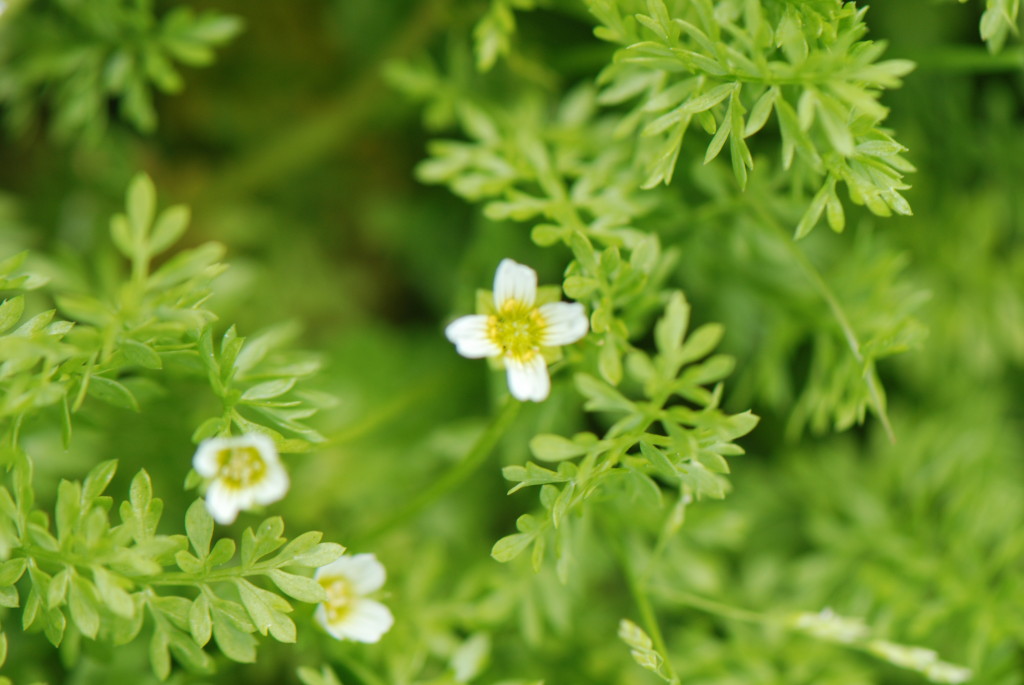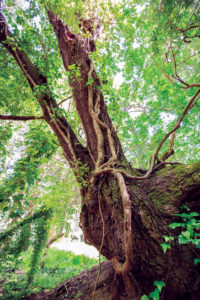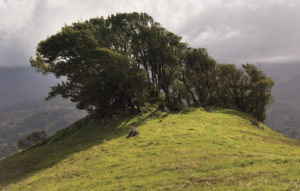ixteen years ago, a botanist and environmental consultant named Eva Buxton went to examine an agricultural field on the San Mateo County coast, where she found her attention drawn to a swath of small flowers, pinpricks of white and yellow in a sea of green. As she moved in for a closer look she saw that the delicate flowers had four white petals and eight yellow stamens. The color seemed almost to melt into the green foliage of the field.
Buxton says now that she doesn’t remember the time of day, or the weather, but she does remember the dawning realization that she’d found something unusual. The plant was clearly in the Limnanthes, or meadowfoam, genus. But meadowfoam flowers in California are pentamerous–that is, they have parts in fives. This one, Buxton clearly saw, had parts in fours. She rushed to consult the definitive reference book on California plants, the Jepson Manual, and found nothing. There were no known tetramerous meadowfoams in California.
Buxton contacted UC Berkeley botanist Dr. Robert Ornduff, a renowned expert on California native plants and Limnanthes in particular, and sent him a specimen. Ornduff knew of no tetramerous meadowfoams in the United States; after consulting a Canadian botanist he suggested that migrating birds might have dropped a few seeds of Macoun’s meadowfoam (Limnanthes macounii), an endangered tetramerous meadowfoam native to the Vancouver Island area in British Columbia. Buxton and Ornduff published a paper together in the “Noteworthy Collections” section of Madroño, the journal of the California Botanical Society, suggesting that the find might be a stray population of Macoun’s meadowfoam, and asking readers to keep an eye out for others.
But Ornduff grew Macoun’s meadowfoam and the new meadowfoam side by side in a common garden, and was able to tell Buxton that they were not the same species after all. The Canadian expert, Adolf Ceska, reached the same conclusion. Whatever this new plant was, Ceska told Buxton, it did “not fit exactly anything known in British Columbia.”
Before Ornduff died of melanoma in 2000, he sent a final email to Buxton that read: “This is a very interesting find; please stay on it.”
otanists have repeatedly searched for evidence of tetramerous meadowfoams in California, going back to the 1970s, when, at Ceska’s suggestion, graduate students at UC Berkeley and UC Davis searched the state for Macoun’s meadowfoam. They found none, and ultimately concluded, Buxton wrote in a 2013 paper in Madroño, “that this species could not have been overlooked, if, in fact, it grew in California.” In the mid-2000s, a graduate student at Oregon State University spent four field seasons combing California and Oregon for tetramerous meadowfoams; he found none. In 2008 Buxton found three more individuals living in a field near Half Moon Bay, but by the next year those had disappeared, and they have not been spotted again.
The one field on the San Mateo County coast, it turns out, is the only known site where the four-part meadowfoam naturally appears.
In 2013, the plant was declared its own subspecies. Buxton, as its discoverer, chose to name it Limnanthes douglasii ssp. ornduffi, to honor the late Ornduff. Earlier this year, a forum of botanists associated with the California Native Plant Society agreed unanimously to classify Ornduff’s meadowfoam as a “1B.1” rare plant, making it eligible for endangered species listing in California and giving it protection under the California Environmental Quality Act.
And so the entirety of the world’s known natural population of Ornduff’s meadowfoam lives out its existence in an agricultural field on the San Mateo Coast. There are people around it all the time. Other plants come and go. The field gets plowed once a year. Somehow the meadowfoam persists. It pervades the field and nearby drainage ditches, and Buxton says it has only declined in population size by 10 percent since its discovery in 1998.
n fact, says CNPS rare plant program assistant Daniel Slakey, Ornduff’s meadowfoam may have been able to survive all these years because of its placement. It is one of only two California plants that have their entire known ranges in a heavily human trafficked area (the other, Calystegia felix, is known only from landscaping in industrial, commercial and residential developments in Southern California). Some of the environmental factors influencing the plant’s future evolution will be inescapably human, Slakey says, which raises an interesting question: “At what point do we draw the line between a wild plant and a cultivated plant?”
“I don’t think anyone has a clear answer to this important question,” Slakey said in an email, “but it’s something we need to think about. I think the raising of this question makes a strong case for restoring populations of this plant in the wild, so that this plant will have a chance at experiencing natural selection again.”
Complicated questions also make saving the meadowfoam tricky. It’s the only naturally occurring population that anyone is aware of, so there’s a case for airlifting it, Franciscan manzanita-style, to safety in an undisclosed nature preserve. But Slakey and others who reviewed the plant’s life history decided that maybe some credit was owed to the process that let Ornduff’s meadowfoam thrive in the field in the first place. In a status review of the plant, Slakey, Aaron Sims, a rare plant botanist at CNPS, and Roxanne Bittman, a botanist at the California Natural Diversity Database, wrote: “given that the current management of the agricultural field has allowed subsp. ornduffi to persist since its initial discovery in 1998, and presumably for a much longer period prior to its discovery, CNPS and CNDDB recommend that the current management regime be continued.”
Or, as Buxton wrote in Madroño last year, “as repeated disturbance of the habitat of L. douglasii subsp. ornduffii appears to be the reason for the plants’ persistence in the agricultural field, no protective measures relating to this subspecies and its habitat should be necessary.”
In short, agriculture seems to work for the meadowfoam, so keep on farming. The landowner has communicated with the farmers to ensure that plowing and grazing remain the same. “The way they’re growing their crops, even if they switch up the crops, it’s important that they time their plowing to allow the plants to go all the way to seed so they can complete their life cycle,” Slakey said—not that there’s any reason to worry, he quickly added.
s the population is monitored over the years, Slakey and CNPS hope to gather more knowledge about Ornduff’s meadowfoam and perhaps experiment more with its environment. Slakey suggested in an interview that it might be interesting for someone to take seeds to plant in different conditions to see what it can withstand and what it cannot.
In November 2010, Buxton went to check on the meadowfoam (she sometimes refers to it lovingly as “my plant”). There were early rains that year, and the farmer had already plowed the field.
“I thought, ‘Uh-oh, now he’s plowed all the seedlings under, and there won’t be any plants come spring 2011,’” she said. But sure enough, spring came and so did her plant. This meadowfoam has resilience!
The extra “.1” in the “1B.1” ranking means that the CNPS forum decided that 80 to 100 percent of the plants are severely threatened, Sims said. If a plant only grows in one place, which happens reasonably regularly, it always gets the .1 ranking. But Sims said this particular plant stands out: “That it only occurs in a non-natural environment represents a unique case for conservation,” he said.
While the plant seems to be doing fine, CNPS is putting together a seed bank for Ornduff’s meadowfoam, just in case.
“A natural disaster could wipe out an entire population, although we don’t necessarily see it going extinct,” Sims said. But because there is always a chance that the plant could die off naturally, for example if a genetic bottleneck occurs and it stops producing viable offspring, no one is taking any chances.
Buxton, the plant’s discoverer, has collected her own seeds. And she’s found at least one other place in the world that Ornduff’s meadowfoam seems to like: She continues to grow the plant in her home garden in Marin.





